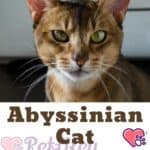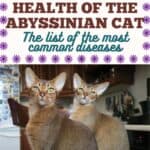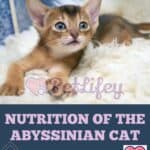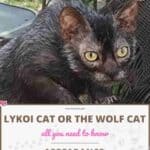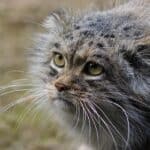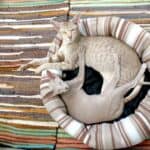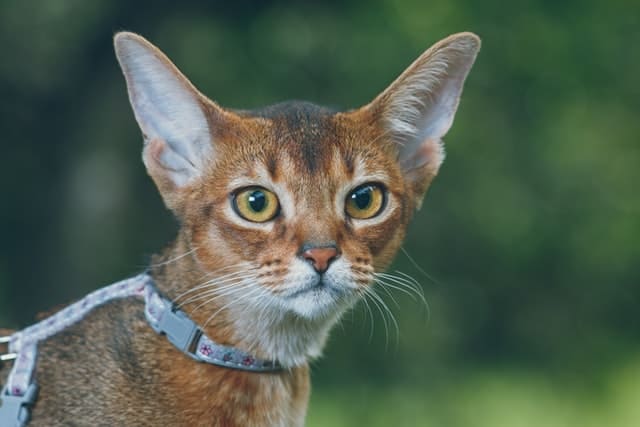
The Abyssinian cat, by its typically feline beauty, can be compared to a miniature puma; it is a particularly effervescent cat, lively, impetuous and independent, but capable of giving a lot of affection and gentleness. Their ideal master must adapt to their liveliness and need for tenderness: he must devote his attentions to them, take care of it, but above all must never tire of playing with them.
The origins of the Abyssinian cat
The idea that the Abyssinian cat is the direct descendant of the Egyptian felines is generally widespread, they whom their beauty and their elegance, associated with their exceptional skill in hunting, had raised to the rank of divinity, and who gave their face and their body to the Egyptian goddess Bastet.
In 1890, in fact, in Egypt, in a cemetery for cats, about two hundred thousand mummies were discovered which, when examined, showed a strong resemblance to the present Abyssinian cat.
This resemblance was confirmed by the discovery, in the Egyptian tombs of the Middle and Late Empires, of frescoes and sculptures which represented him. The Abyssinian race arrived in Europe, and specifically in Great Britain, around 1860, at the end of the Anglo-Abyssinian war. The Ethiopian Cat was then mated to red cats and silver tabby’s and, through a breeding program, the European strain of Abyssinians was obtained.
Official recognition of the Abyssinian cat breed dates back to 1886. We especially appreciated the unity of color that characterized the Abyssinian fur: a beautiful brown speckled with black, with an apricot-colored undercoat. In 1957, the red color was officially recognized and accepted, and recently, blue and lilac tones have also been appreciated.
The ideal cat
The particular structure of the Abyssinian cat makes it agile, leaping and very elegant in appearance. The head, whose contours are round, is longer than wide, of medium size, proportionate to the body; the muzzle is rounded and the intersection of the nose and forehead is slightly marked.
The profile, without flat sides, connects the muzzle, the browbones and the forehead in a continuous curve; in adult males, the cheeks may be a little full. The chin, which is round in shape, appears full, strong and not protruding.
The eyes of the Abyssinian cat, in the shape of a large almond, are large, shiny, very expressive and particular because they are highlighted by the dark skin of the eyelids, surrounded by a lighter area where we can notice a “stroke of dark pencil that reaches up to the upper eyelid.
The ears, open and deep at the base, are wide, cup-shaped, tilted forward and set wide apart, so much so that the cat always appears to be listening and on the lookout. On the ears, the hair is short; it is preferred that on the back of the ears appear a design in the form of a thumbprint.
The body appears slender, of medium length, tapered and the musculature is robust and solid; the rib cage is rounded and the flanks are straight. The legs are slender, long and carried by small, oval feet which give it a graceful and light appearance.
The general appearance shows a slightly arched neck and back, as if the cat is about to jump.
The tail is long, broad at the base and gradually tapers to the tip. The hair, endowed with elastic resistance, is of a fine texture and appears shiny and soft to the touch; of medium length on the backbone, it is shorter on the flanks, nape, head and legs.
Hair color
What characterizes the Abyssinian cat is the mainly red color of its coat, which is light at the root and darker at the tip (ticking).
All ticked tabby colors are allowed, with a ticked design without traces of tabby except for the head, as well as the color silver silver.
The Ruddy (hare) variety is dark terracotta; it usually has a strong redness and two or three bands, black or dark brown, on the tip of each hair.
Short-haired body parts should show at least one ticking band . Subjects whose coat is characterized by a lot of ticking may have darker backbones.
The lower part of the body, the chest and the inside of the legs must present a color with light reddish tones without ticking or marking.
On the body , the color can vary from apricot to dark terracotta, but it is best if the tone is as warm and intense as possible.
The hair around the nose, lips, chin, and upper throat may be white / cream.
The tail, unstriped and without grey tones, has a black tipping, the toes can be black or dark brown, and between the toes it should be black. The nose appears brick red, edged with black or dark brown.
The Chocolate and Sorrel varieties are nothing more than diluted, and more reddish-toned forms of the Ruddy variety. The chocolate color replaces the black, the fingers are pink with chocolate-colored hairs between them and the nose is pink.
In the Blue variety, the coat is a thin warm grey color, with deep dark grey ticking; the breast, belly and inside of the legs are pale cream, the toes are blue to pinkish tint, with darker blue between the toes, and the nose is pink.
The Lilac variety is similar to Blue, but the tones are lighter and more delicate and the fingers are pink in color.
The Fawn variety is a cool pinkish cream color, with slightly darker ticking. Pale cream characterizes the color of the chest, belly and inside of the legs; the toes are light pink, with a darker pink between the fingers and the nose is pink.
For all these varieties, the color of the eyes, which must be very intense, can be: gold, copper, green or hazelnut ; in the Silver variant, the color can be emerald or green-blue.
The character
The Abyssinian cat is a dapper animal, particularly intelligent and clever, leaping, fast and always on the move, like a real sportsman.
It is always attentive, vigilant and interested in everything that moves: it is precisely these characteristics that make them dynamic and tireless.
Although a very independent cat , it is sensitive and needs a lot of affection; this need manifests itself in an accentuated and continuous way, to the point of being insistent.
They really enjoys being petted and hugged and to get these attentions from his master, it rubs against him purring. Being petted seems to be a vital necessity for them!
At first they tends to be suspicious , but if treated with respect and serenity they shows his good temper; in general, it tends to befriend one person and does not seem to appreciate the presence of strangers.
The Abyssinian uses their meow, in an expressive and insistent way, to communicate their needs and state of mind: it emits several sounds depending on the situation; despite its insistence, meows are never obnoxious or penetrating, as they have a gentle tone and almost musical sound. It is a cat that does not go unnoticed but we cannot say that it is accommodating: you must therefore make the effort to understand it more than other cats.
One of the most effective ways to gain esteem is through gambling. In the game, it considers man as a similar and forgets the great differences that characterize them. Contrary to what we think of cats, the Abyssinian has a good relationship with water: occasionally, it proves to be a good swimmer.
Hug:
Although very active, the Bunny Cat is also very affectionate in general, capable of sweets and sweet moments with their humans. Some individuals even go so far as to beg for almost non-stop caresses!
Player:
This cat likes heights and needs to spend his energy playing a lot and often. It is interested in everything that moves and seems tireless at times.
Calm:
Although some individuals are the embodiment of calm, this tomcat is more frequently full of life and sometimes even boisterous. Their physical abilities must have something to do with it …
Intelligent:
Their natural curiosity gives them a reputation as a small tornado wanting to be everywhere at the same time and actively participate in the life of their adopter.
Fearful / suspicious of strangers:
More often curious than fearful, it usually adapts well, but can take a long time to get there.
Independent:
This breed of cats is usually quite independent and able to have fun on their own. However, they will enjoy the company of their humans just as much as the solitude.
Behaviour
Talkative: A good singer, this cat’s register is melodious and diverse, and their voice is more discreet than strong.
Greedy / gluttonous:
To spend so much energy, the Bunny Cat is also a very good eater who can even come and steal food directly from the table… The interactive bowls will be the order of the day for this clever little fellow!
Need for exercise: A small feline athlete, the Abyssinian needs to play and exercise every day. It may even surprise us with his prowess in agility.
Runaway:
The Rabbit Cat may show a desire to explore further and further in order to satisfy its curiosity, but it generally remains loyal to its humans.
Compatibility
The Abyssinian and the Dogs:
With a good introduction, a Bunny Cat will get along well with dogs and may even want to play with them. If the agreement is less synergistic, the heights will easily allow kitty to find respite and tranquillity.
The Abyssinian and the Other Cats:
This tomcat does not need feline companionship, but it will adapt to it if given time and a good introduction is prepared.
The Abyssinian and the Children:
Lively and active, the Rabbit Cat will be happy in a family with children, but it will be necessary to pay attention that the latter respect the needs of the cat. In general, they will be happy to play together. Watch out for nonsense!
The Abyssinian and the Elderly:
The Bunny Cat’s high physical activity needs do not make them an ideal cat for a very quiet person. Although it appreciates a lot of caresses, it will risk getting bored and inventing activities, which will earn them a reputation of painful …
Maintenance
Grooming:
Very easy to maintain, the Rabbit Cat requires a simple weekly brushing. A chamois leather can also be used to further shine your coat.
Hair
loss : The Abyssinian cat’s hair loss is minimal, especially if it is brushed once a week and eats quality food.
Food
By being very active, this feline sometimes has a little higher caloric needs than the quieter breeds of cats. However, you have to be careful not to overfeed him because being overweight will quickly affect his physical capacities and his well-being in general.
Health
Life
expectancy : The life expectancy of the Abyssinian is on average 13 to 15 years.
Resistant / robust:
Although it is a short-haired cat, the presence of an undercoat gives it an average resistance to cold and heat.
Tendency to gain
weight : The extra weight will show up very quickly on his slender little body, but if he stays active, that shouldn’t be a problem.
Common diseases:
Although the Bunny Cat can develop, one day or another, all the known pathologies of the domestic cat, certain genetic diseases are a little more common:
- Pyruvate kinase deficiency, which causes anemia (a genetic test is available)
- The Atrophy Progressive Retinal, resulting in blindness (a genetic test is available)
- Amyloidosis, which leads to irreversible renal failure following the deposition of amyloid substance in the body. (No genetic test for the moment but the caution and vigilance of the breeders have nevertheless reduced the disease).
Periodontal disease (gingivitis and tartar) is also reported to be somewhat fragile and it is therefore recommended to pay attention to the dental care that is necessary for them.
Despite everything, overall, this feline is generally in good health.
Reproduction:
The number of kittens per litter averages 3, which is less than the majority of other domestic cat breeds. Kittens are born two-colored and the ticking of their coat only appears around 6 weeks. Their final color takes a year to a year and a half to set.
Good to know:
The different coat colors each have their own unique softness, due to the variable distribution of pigments on the hair.
Cares
Whoever chooses an Abyssinian cat for a companion cannot ignore his exuberance and their desire for freedom. Because of these two characteristics, it is important that it lives in an open and spacious place, the ideal being a house with a garden and trees. It can also adapt to the apartment as long as one never makes the mistake of letting him go out into larger spaces: he would become sad and dissatisfied.
The diet of the Abyssinian cat deserves special attention. Compared to its congeners, it consumes a large amount of food, because of its intense physical activity during the day; it is therefore important to provide him with all the substances it needs, without exaggerating the quantities. Indeed, excessive food consumption could weigh down its agile and slender figure. It is also advisable to administer vitamin and mineral supplements.
Price
On average, the purchase price of an Abyssinian in breeding is between 712.66 USD and 1900.42 USD, the price varying according to the line, the reputation of the breeding, age, sex, etc. For the monthly budget, it will take an average of 35.63 USD / month to meet the needs of a cat of this breed, by offering him a quality diet and making sure to maintain him in good health.

